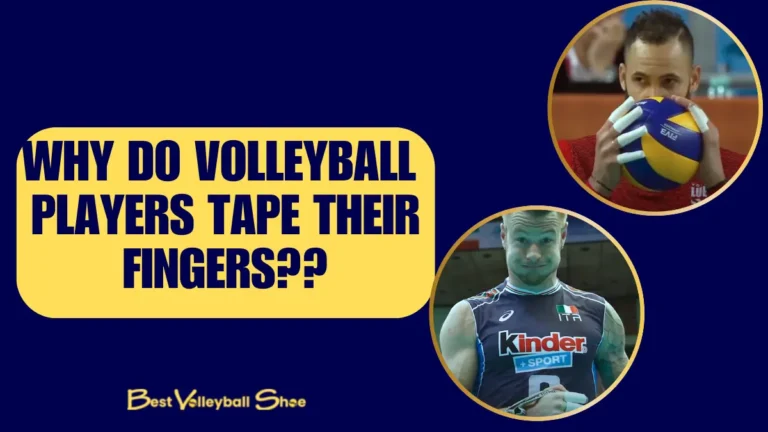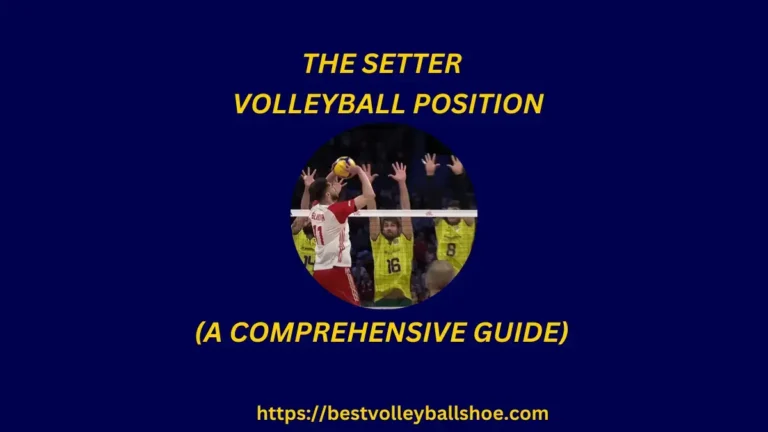Outside Hitter Volleyball Position: A Comprehensive Guide
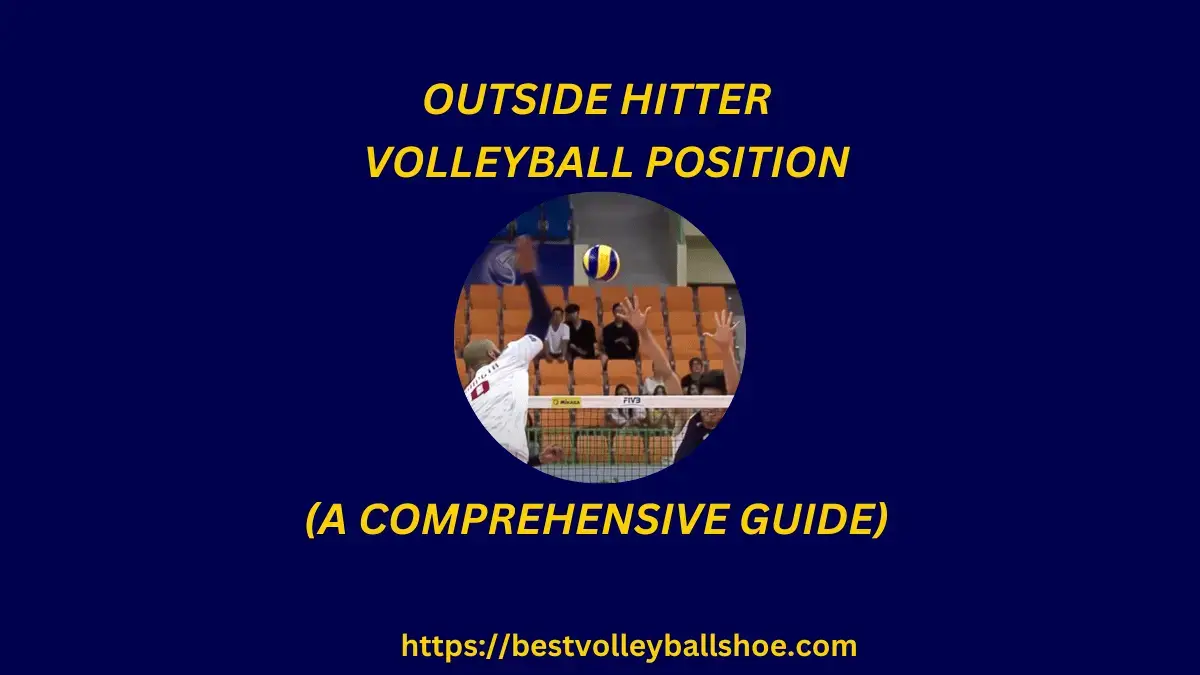
The outside hitter volleyball, the attack specialist, is regarded as the point-scoring machine of a team. They are positioned on the left side of the court and are also called left-side hitters or left-wing spikers. They get more sets in a match than any other player on the team.
In this article, we will explore different basic aspects of this playing position, including volleyball terms, history, volleyball rules, playing position, rotation, role, importance, qualities, physical attributes, and the pieces of equipment including the best volleyball shoes for this position.
Finally, we will evaluate the recruitment standards and essential tips for becoming a better Outside Hitter Volleyball.
So let’s dive into this charismatic volleyball position.
What is an Outside Hitter Volleyball?
Playing in the left front, the outside hitter is often the strongest spiker on the team. They tend to be pretty tall but don’t have to be the tallest. The middle blocker is often the tallest on the team since their primary job is blocking.
The outside hitter, however, should be pretty tall because they must block as well, which is a really important duty for them. He is assigned important roles in both defense and offense.
Terms for Outside Hitter Volleyball
Outside hitter volleyball is also known as
- Spiker,
- cannon
- Left-side hitter
- Left-Wing Spiker
Considering the various attack selections outside hitters perform
- kill
- Tipping
- Spikes.
Historical Perspective
The concept of specialized player positions, including the outside hitter, emerged gradually with the evolution of volleyball. The introduction of distinct positions in volleyball is not attributed to a specific date, but rather to the sport’s development over time.
As the game became more organized and strategies evolved, players naturally started to take on specific roles based on their skills and positions on the court.
However, the introduction of the outside hitter position can be presumed to be included in volleyball with the inception of set and spike rules in 1916 in the Philippines.
The set and spike rule gave birth to the rule of three hits, allowing a maximum of 03 hits for returning the ball to the opponent’s court. The third hit was to be spiked by the player powerfully over the net. This is what may have given the dedicated role to the outside hitter position over time
Rules for Outside Hitter Volleyball
According to USA volleyball rules, an outside hitter volleyball has to follow the following set of rules like any other volleyball player. These rules are as under:
- None of his body parts should come in contact with the net between antennas while play is in progress.
- Like any other player, they are not allowed to block the serve.
- It’s also prohibited for them to go under the net, in the opponent’s court area.
- He will move and rotate clockwise after every serve.
- They are prohibited from Touching the ball or opponent in their space during or before the attack.
- After blocking they can also pass the ball- according to rule 3 of US volleyball, contacts excluding blocks are allowed for returning the ball back to the opponent. Thus, after blocking the ball into their side the outside hitter can pass the ball.
Playing Position, Rotation, and Substitution
The base position of an outside hitter is 04 and 05.
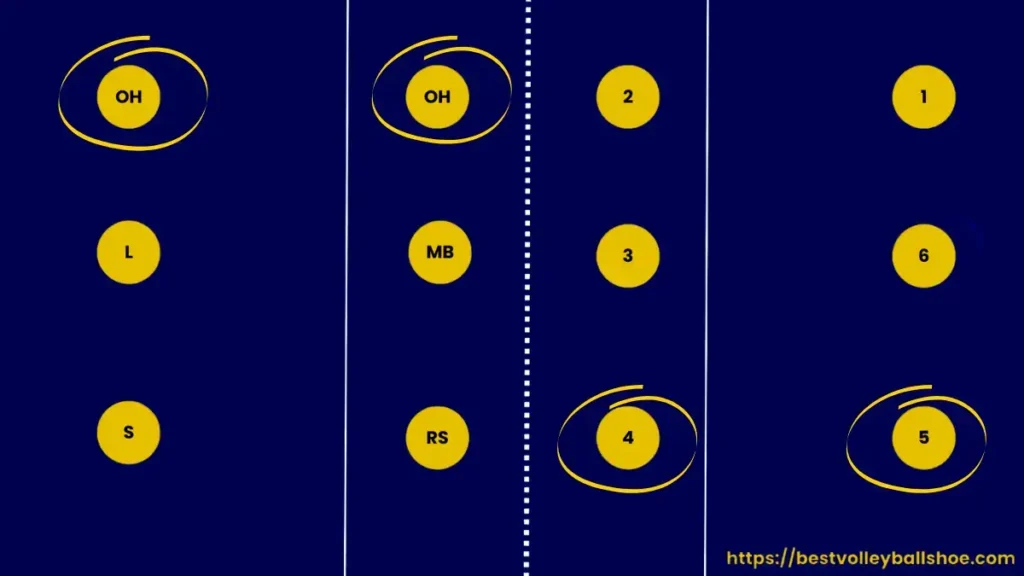
However, in a 5-1, rotation both outside hitters are opposite to each other i.e. if one is at position 01 the other will be at 04, and similarly for positions 2 and 3 where outside hitters will be at position 05 and 06 respectively.
On serve receive, both are positioned on the right and left of the libero to receive the serve.
Here is the video of understanding the 5-1 rotation in detail and easily.

In the 6-0 formation in volleyball, players do not have specialized positions or functions. This means there isn’t a designated outside hitter as you would find in other formations. Since no permanent outside hitter exists in this formation, players must adapt to different positions and playstyles as the game progresses.
Roles and Responsibilities of an Outside Hitter
Left-side hitters/outside hitters are the complete volleyball players. They possess multiple volleyball skills, from serving to blocking and hitting to passing. Following are the brief of their roles and responsibilities.
- Serving
- Hitting/spiking
- Serve Reception and Passing
- Blocking
- Judging the opponent’s hitters and anticipating the play
- Calling out play
Serving
Like any other player except libero, they’re also responsible for serving. Effective serve is essential to put the opponent under pressure.
Digging
When the outside hitter does not receive the set, their role swiftly transforms from offensive to defensive coverage position. This shift is crucial to anticipate potential attacks from the opposing team and contribute effectively to their team’s defense.
Furthermore, the outside hitter’s role is not restricted to only digging the ball, but it also extends to covering the blockers. This means being prepared for any deflections caused by their team’s block attempt. By monitoring the movements of the blockers, they can swiftly adjust their position to retrieve the ball and sustain the rally.
Serve Reception and Passing
Outside is also responsible for assisting the libero in receiving service. They are equally important in the back row as libero and as they have to pass the ball from this position.
Opponent players often target the outside hitter due to their weak passing skills compared to libero.
Hitting
After receiving the serve and passing, the next job of the outside hitters is to get positioned for Spike. It is their prime responsibility to be ready to spike the ball effectively.
There is a likelihood of some error regarding the quality of the set, sometimes it may be easy or tough, high or low as well as slow or fast. So, a prompt response from the hitter to capitalize on each opportunity is appreciable.
Blocking
While playing in the left front zone, the outside hitter is primarily responsible for blocking anything behind the center or to the left of your middle blocker.
At blocking, the most common block is blocking the right-side attacker, whereas the second most common block is helping to block the middle or a front one or a bad one, and the third type of set he might block is either a back two or a slide.
Judging the Opponent Hitters
Outside hitters often judge and inform their fellow players about the opponent hitters’ movements and attacks including tricky ones like tipping, dumping, or cutting.
Calling Out Play
In volleyball, calling out play is a technique where players, using various signals or terms, ask teammates about what kind of play is to be executed. This communication is especially important for outside hitters as they initiate attacks most of the time.
For instance, an outside hitter might call out a “slide” or “quick play”. In the former, he runs behind the setter and spikes the ball from a different angle, while in the latter, he makes a fast attack on the ball before setting up a block by the opponent blockers.
In short, by calling out play outside hitter can assist teammates by anticipating their moves and executing the play effectively. Moreover, this also confuses the opponent in judging the attack and defending it.
Importance of an Outside Hitter
The outside hitter holds one of the toughest positions on the volleyball court and is of paramount importance in the game. They are the second most important player after the setter.
Their role extends far beyond just hitting the ball and scoring points. Here are several points to show the importance of an outside hitter on the team:
They are the Offensive Powerhouse of a volleyball team.
Outside hitters are typically the primary offensive weapons of the team and receive the major chunk of the sets.
Their ability to consistently deliver powerful and accurate spikes places immense pressure on the opposing team’s defense.
This offensive threat opens up opportunities for other players and keeps the opposing blockers guessing, creating gaps for the team to exploit.
The outside hitter’s capacity to convert successful hits into points is a game-changer.
A well-executed spike by the outside hitter volleyball can immediately swing the momentum of a match, energizing both the team and the fans.
Consistent point-scoring by the outside hitters can demoralize the opposing team and give their own team a psychological edge.
Effective outside hitters contribute significantly to the team’s defense as well.
Qualities and Strength of an Outside Hitter
Excellent Hitting
Strong outside hitters are best at swinging their arms and hitting the ball with power, accuracy, and versatility. They are not dependent on specific angles or positions in the court for a kill.
They are best at deceiving the opponent with the direction, speed, and intensity of their shots, and are masters in tipping, spiking, rolling, and pushing the ball.
Being predictable in your spikes gives a competitive edge to the opponent and chances of being blocked also increase manifold.
So outstanding hitters cannot be anticipated easily by the opponent about where they plan to hit the ball. Regardless of the type of set they receive, their approach and body positioning remain consistent, making it incredibly difficult for the opposing team to judge their next move.
Defensive and passing Skills
It is very easy to spike/serve a ball tossed in the air, but it is multiple times difficult to dig/receive and pass that ball. So receiving the serve and passing the ball is 180 degrees different from spiking.
Excellent passing skills make great opposite hitters. On the other hand, outsides with poor passing skills will be the target of the opponent servers for obvious reasons.
Thus, being a good digger or serve receiver and passer is a plus point. A good pass decides the quality of the set. In fact, great outside hitters are always good passers.
High Vertical jump
Outsides have decent vertical jumps, which can fill the height gap. Although they are quite shorter than middle blockers and opposite hitters they cover this gap by their jumping ability.
Communication
He Should establish good communication, both verbally and non-verbally, with the teammates, especially the setter in order to receive the required set for hitting. Verbal communication involves coordination with teammates, coaches, and sometimes referees. Whereas, with non-verbal this player uses signals to convey messages or directions. Nonverbal communication is mainly done in noisy environments or to ensure discrete communication.
Physical Attributes of an Outside Hitter Volleyball
Agility
Outside hitters are the primary spikers on the volleyball team. Like any other volleyball player, he also has to be agile and quick in his movements.
As an outside hitter, you can’t always just stand and deliver instead, you have to quickly move and change your spike positions.
For instance, if a left-side spiker is hitting persistently from the left corner of the court he will be predictable and likely to get blocked. On the other hand, if he signals the setter about setting the ball at different positions he might get a successful kill.
Strength
The outside hitter is like a fast bowler in cricket. He should have strong arms and legs, Strong arms are essential for powerful spikes whereas legs are important for high vertical jump
Well-Heighted
Generally, height is an important physical attribute for all volleyball positions except libero and defensive specialist. Heightened outside hitter adds depth to both the blocking and attacking capabilities of the team. This is why, the clubs at the international level prefer a well heighted outside hitter.
Flexibility
Important for avoiding injuries while carrying out tough movements.
Endurance
To meet the game requirement and achieve the highest performance.
Hand-eye coordination
for a quick reaction after judging the tricky balls like tipping, dumping, or cutting.
Mental strength
To handle the pressure situation and maintain consistency
Recruitment Standards for Outside Hitters at Collegiate
I have briefly described various introductory aspects of the outside hitter volleyball position including introduction, history, rules, role and responsibilities, qualities, and physical attributes.
The abovementioned information mostly covers the basics and is generic for all readers. However, from this section, I am addressing those who are looking for a career or who have plenty of experience as a volleyball player. Here are the various guidelines for the recruitment of an outside hitter at the college level in the USA.
According to the NCSA, the recruitment standards for the women outside hitters are given below mentioned graph. The prime factors for recruitment include
- Height,
- Standing Reach,
- Attack jump,
- Block Jump,
- Vertical Jump,
- Experience.
Recruitment guidelines for Women:
As per guidelines the average height for outside hitters at the college level in the USA is 155.448 cm, standing to reach 240.792cm, attack jump 277.368, block jump 277.368, and verticle jump 606.552 cm.
As regards the experience, a woman outside hitter should have open-level playing club experience. This is to gauge the knowledge of the game and position.
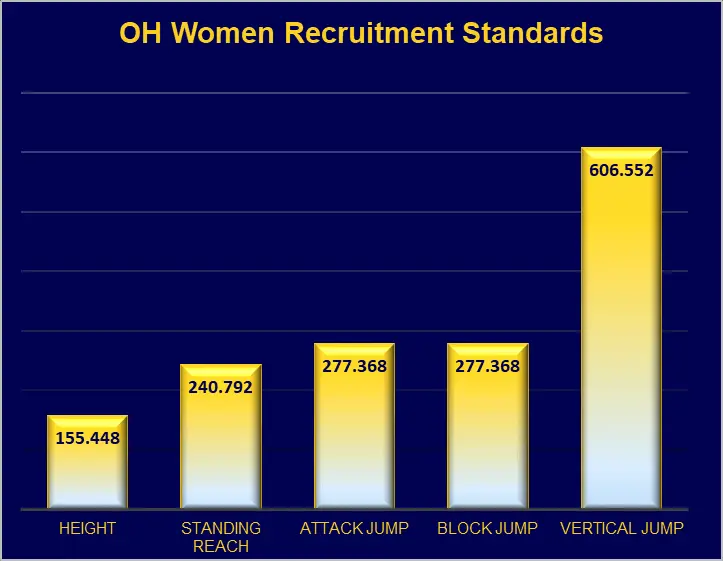
Recruitment guidelines for Men:
The recruitment guidelines for men’s outside hitters aren’t formally available like women. However, the few stats data that are available include height and approach jump. The stats are as under:
Height
Depending on various playing levels and divisions of NCSA the average height for a volleyball player is between 6’’ to 6’.6’’. This data shows that the outside hitters are not the tallest volleyball players. On the other hand, they are also not the shorter ones. Importantly, a tall outside hitter has an edge when selection.
Approach Jump
The average approach jump for an outside hitter is 10’8’’.
Is outside hitter an excellent position to play in volleyball?
Yes! The outside hitter volleyball is an excellent position to play. He is among the most notable players on the volleyball court because of his powerful spikes. This is also the reason for outside hitters being more popular.
At the professional level, it also has a great scope because the clubs prefer to hire a strong and tall foreign outside hitter. So, being a tall and strong outside hitter with good playing skills you have a great career opportunity. Having said this, this position is equally demanding as you have to play at more rotations.
Should I be an outside hitter?
There are a few points and other aspects to keep in mind while deciding to be an outside hitter
Firstly, what is your interest if you like to swing your arms and feel overwhelmed after powerfully hitting the ball into the opponent’s side of the court, and you enjoy the movement of joy after a kill? Then of course! You should opt for this position.
Secondly, what is your height, standing reach, and jumping reach? If you’re a shorter athlete with low standing and jumping reach, then you should opt for other positions as you can’t be selected.
For clarity, I will mention the average height calculated from the top ten outside hitters in the world. It is 200.2 cm or 6’5.6’’, which is quite a significant number and excludes more than 95% of the population.
However, if you are a shorter athlete, you can look for other positions like Volleyball liberos and setters. I have comprehensive details for these positions.
How to be a better outside hitter?
Improve your jump
As I have mentioned earlier and also evident from the recruiting guidelines, an outside hitter should have a decent vertical jump.
So I will advise you to spend more time in the gym polishing your jumping skills.
Improve your Passing by Repetitions
As an outside hitter passing, in addition to hitting, will be with you throughout your career.
When it comes to passing, I’m talking about getting that ball to your setter with pinpoint precision. You want to create a solid platform with your forearms by clasping your hands together, forming a kind of flat surface.
Moreover, you also have to be good at passing to avoid becoming the target of opponent servers.
The best way to improve your passing skills is to pass more and more and make a buddy who is going to accompany you for training.
You may practice passing both at home and at the court. The following video may be helpful in this regard.
DO more hitting
The only way to bring the skill to perfection is through practice and repetition. The more you practice, the more the perfection you get.
You may practice hitting on the court.
Critically Watch videos of the best Outside hitters
It is agreed that world-class players are trained by highly qualified coaches and staff. Critically watching their videos can be a practical demonstration of their learning from their coaches.
So, it can be incredibly beneficial for your development as an outside hitter volleyball.
Understanding your mistakes
It is pertinent to train and work on your mistakes after watching the videos. Otherwise, you won’t be able to get more than enjoyment like a spectator
Volleyball gears for an Outside hitter
Volleyball Shoes
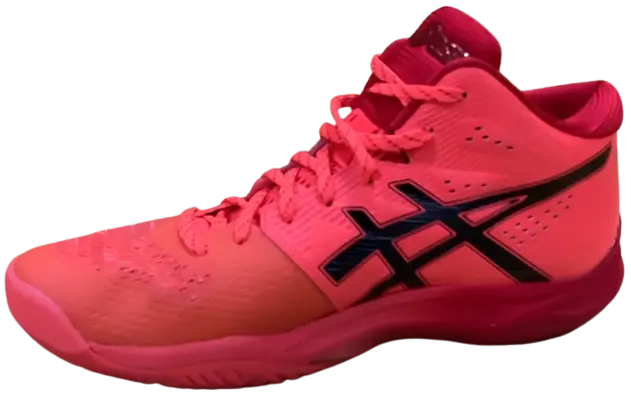
ASICS Sky Elite FF MT-2
Popular, Premium, and Best Asics Volleyball shoes. A good combination of flexibility, comfort, breathability, and heel-to-toe transition.
Volleyball Kneepads
FAQs Outside Hitter Volleyball
Is the outside hitter a spiker?
The Outside hitter is also known as left left-side or left-wing spiker. He is the primary spiker of the team. Outside hitters are regarded as the scoring machine and get more sets in a match than any other player on the team.
What is the difference between an Outside Hitter and an opposite hitter?
The first and foremost difference is the playing position of both players. Outside hitters are the left-wing spikers and are positioned at position 04 or 05, whereas opposite hitters are positioned on the right side of the court and known as the right side or right-wing spikers.

